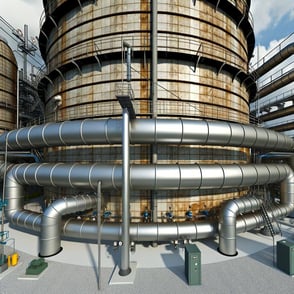Lithium-Ion Batteries
Lithium-ion batteries are high-energy, rechargeable batteries used in electronics, EVs, and renewable energy storage, offering efficiency, long life, and essential grid stability support.
What Are Lithium-Ion Batteries?
Lithium-ion batteries (Li-ion batteries) are chemical storage systems that utilize lithium ions as the primary component of their electrochemical reactions. Known for their high energy density, long cycle life, and low self-discharge rate, lithium-ion batteries have become the dominant technology for portable electronics, electric vehicles (EVs), and various renewable energy applications. Their efficiency and versatility make them essential in modern energy storage solutions.
How Lithium-Ion Batteries Work
Lithium-ion batteries consist of several key components: an anode, a cathode, an electrolyte, and a separator. The anode is typically made of graphite, while the cathode is composed of a lithium metal oxide, such as lithium cobalt oxide, lithium iron phosphate, or lithium manganese oxide. These materials are chosen for their ability to store and release lithium ions during the charge and discharge cycles. The electrolyte, a lithium salt dissolved in an organic solvent, allows lithium ions to move between the anode and cathode. Commonly used electrolytes include lithium hexafluorophosphate (LiPF6) in a mixture of organic solvents like ethylene carbonate and dimethyl carbonate. The separator is a porous membrane that prevents direct contact between the anode and cathode while allowing lithium ions to pass through, crucial for the battery's safety and efficiency.
During the charging process, lithium ions move from the cathode to the anode through the electrolyte. Electrons flow through an external circuit from the cathode to the anode, storing energy in the process. This causes the anode to become negatively charged and the cathode to become positively charged. During discharging, the lithium ions move back from the anode to the cathode through the electrolyte, while electrons flow through the external circuit from the anode to the cathode, providing electrical energy to whatever is connected to the battery, releasing the stored energy.

*Image by Sdk16420, licensed under CC BY-SA 4.0
There are several types of lithium-ion batteries, each with specific characteristics tailored to different applications. Lithium cobalt oxide (LiCoO2) batteries, known for high energy density, are commonly used in smartphones, laptops, and digital cameras, although they have a shorter lifespan and lower thermal stability compared to other types. Lithium iron phosphate (LiFePO4) batteries offer excellent thermal stability, long cycle life, and safety, making them ideal for electric vehicles, energy storage systems, and power tools. Lithium manganese oxide (LiMn2O4) batteries are known for high thermal stability and safety, used in medical devices, power tools, and electric bikes, offering moderate energy density and a long lifespan. Lithium nickel manganese cobalt oxide (LiNiMnCoO2 or NMC) batteries combine high energy density and safety, widely used in electric vehicles and energy storage systems, offering a balance between energy density, lifespan, and safety. Lithium nickel cobalt aluminum oxide (LiNiCoAlO2 or NCA) batteries provide high energy density and are commonly used in electric vehicles, offering a long lifespan and good thermal stability, making them suitable for demanding applications.
The Impact of Lithium-Ion Batteries on the Energy Sector
Lithium-ion batteries have a significant impact on the energy sector, particularly in integrating renewable energy sources like solar and wind power into the grid. They can store excess energy generated during periods of low demand and release it during peak demand, ensuring a stable and reliable power supply. By providing energy storage solutions that respond quickly to fluctuations in supply and demand, lithium-ion batteries help maintain grid stability and offer ancillary services such as frequency regulation and voltage support, enhancing overall grid reliability.
The adoption of lithium-ion batteries in electric vehicles (EVs) has revolutionized the transportation sector. These batteries provide the high energy density required for long driving ranges and quick recharging times, making EVs a viable alternative to traditional gasoline-powered vehicles. The cost of lithium-ion batteries has decreased significantly over the past decade, making them more accessible for various applications. Their high energy efficiency and long cycle life contribute to lower overall costs and improved energy utilization.
While lithium-ion batteries offer numerous benefits, their production and disposal raise environmental concerns. Mining lithium and other raw materials can have significant ecological impacts, and improper disposal of batteries can lead to hazardous waste. Recycling initiatives and advancements in battery technology aim to mitigate these environmental challenges.
Conclusion
Lithium-ion batteries are a cornerstone of modern energy storage solutions, offering high energy density, efficiency, and versatility. They play a crucial role in renewable energy integration, grid stability, and the adoption of electric vehicles. As the demand for clean and reliable energy continues to grow, lithium-ion batteries will play an increasingly important role in ensuring a sustainable and resilient energy future.
Glossary
- Lithium-Ion Batteries (Li-ion Batteries): Rechargeable energy storage devices that use lithium ions as the primary component of their electrochemical reactions.
- Anode: The negative electrode in a battery where lithium ions are stored during charging.
- Cathode: The positive electrode in a battery where lithium ions are stored during discharging.
- Electrolyte: A lithium salt dissolved in an organic solvent that allows lithium ions to move between the anode and cathode.
- Separator: A porous membrane that prevents direct contact between the anode and cathode while allowing lithium ions to pass through.
- Energy Density: The amount of energy stored in a given volume or mass of a battery.
- Cycle Life: The number of complete charge and discharge cycles a battery can undergo before its capacity significantly degrades.
- Self-Discharge Rate: The rate at which a battery loses its charge when not in use.
- Electric Vehicles (EVs): Vehicles powered by electric motors using energy stored in rechargeable batteries.
- Renewable Energy Integration: The process of incorporating renewable energy sources such as solar and wind power into the energy grid.
- Grid Storage: The use of energy storage systems to provide backup power, load leveling, and frequency regulation in the electrical grid.
- Frequency Regulation: The process of maintaining the stability of the electrical grid's frequency by balancing supply and demand.
- Voltage Support: The provision of reactive power to maintain voltage levels within the required range for grid stability.
.png?width=200&height=80&name=etpa-logo-color%20(1).png)































.png)
.png)
-1.png?width=250&height=100&name=etpa-logo-color%20(1)-1.png)